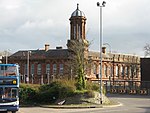Shortlees A.F.C.
2010 establishments in ScotlandAmateur association football in ScotlandAmateur association football teamsAssociation football clubs established in 2010Football clubs in Scotland ... and 2 more
Football in East AyrshireSport in Kilmarnock
Shortlees Amateurs Football Club is a Scottish football club based in Kilmarnock, East Ayrshire, representing the neighbourhood of Shortlees. In 2018 they won the Scottish Amateur Cup, granting entry to the following season's senior Scottish Cup for the first time in their history.
Excerpt from the Wikipedia article Shortlees A.F.C. (License: CC BY-SA 3.0, Authors).Shortlees A.F.C.
Burnpark Road,
Geographical coordinates (GPS) Address Nearby Places Show on map
Geographical coordinates (GPS)
| Latitude | Longitude |
|---|---|
| N 55.586891 ° | E -4.499599 ° |
Address
Burnpark Road
Burnpark Road
KA1 4SD , Shortlees
Scotland, United Kingdom
Open on Google Maps








